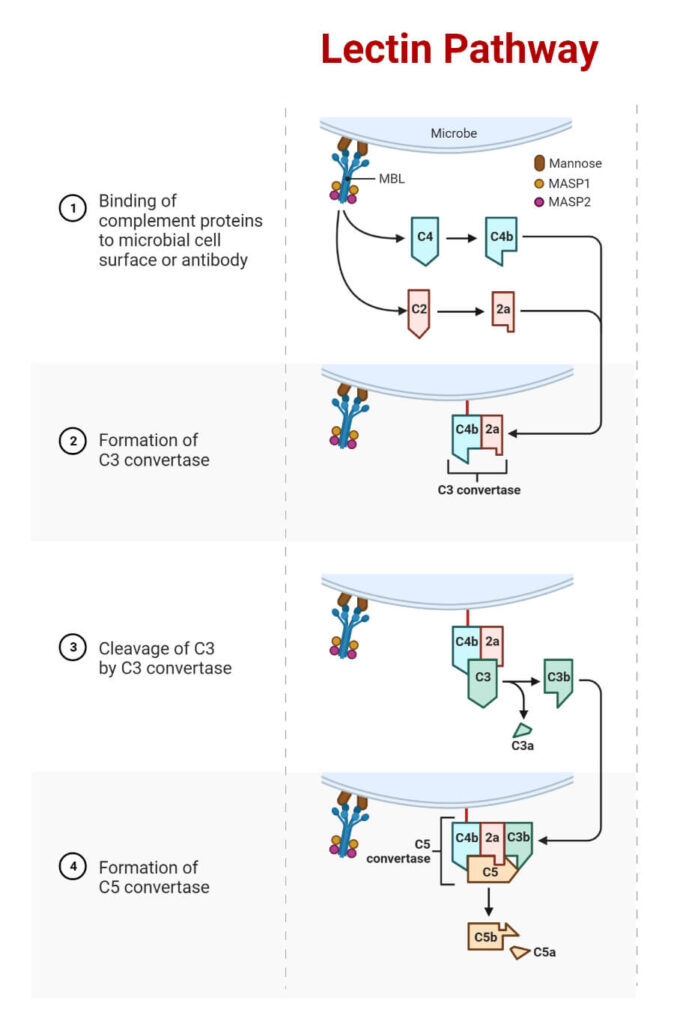The complement system is part of the immune system that helps enhance the ability of antibodies and phagocytic cells to clear pathogens. It consists of a cascade of proteins that can amplify the immune response, leading to inflammation, cell lysis, and opsonization.
Complement System Pathways :
The complement system can be activated through three main pathways:
- Classical Pathway
- Alternative Pathway
- Mannose Binding Lectin (MBL) Pathway
Classical Pathway
The classical pathway begins with the formation of an antigen-antibody complex. This complex exposes a binding site for the C1 complex (composed of C1q, C1r & C1s)
- C1q binds to the antigen bound antibody (Fc portion) where C1r and C1s are proteases which cleave C4 and C2 to form into two subunits and form C4b2a.
- The C4b2a complex is also called the C3 convertase that breaks the C3 molecule into two subunits C3a and C3b.
- The C3b unit combines with C4b2a to form the C4a2a3b complex.
- C4b2a3b is also called C5 convertase that breaks the C5 molecule into two subunits C5a & C5b.
- Then the C5 unit binds to C6, C7, C8, C9 respectively, forming the Membrane Attack Complex (MAC) the C5b6b7b8b9b. This MAC causes a pore on the surface of the target cell and cell lysis occurs.

Alternative Pathway
Alternative pathway is triggered by microbes or bacterial endotoxin by spontaneous hydrolysis of C3 factor/complement protein.
- The C3 protein breaks into C3a and C3b subunits and combines with the larger subunit of factor B and forms C3bBb.
- The complex C3bBb is the C3 convertase that again breaks the C3 molecule into C3a and C3b subunits.
- C3bBb complex combined with C3b and form С3Вb3b complex.
- The C3bBb3b complex is the C5 convertase that breaks the C5 molecule into two fragments of C5a and C5b.
- Then the C5b fragment breaks C6, C7, C8, C9 respectively and binds the larger subunits to form the Membrane Attack Complex (MAC)- C5b6bC7b8b9b. This MAC makes a hole on the surface of the target cell and lysis of the cell occurs.

Mannose Binding Lectin (MBL) Pathway:
MBL pathway is initiated by the binding of mannose binding lectin (MBL) to bacterial surfaces.
- Binding of MBL to a pathogen results in activation of MBL associated serine proteases 1 & 2. The association of MASP 1 and MASP 2 with MBL acts as a C1 complement molecule.
- Formation of MASP complex results the activation and subsequent cleavage of C4 into C4a & C4b and also C2 into C2a and C2b.
- The C4b fragment bind with C2a and form the C4b2a complex (C3 Convertase).
- The C3 Convertase breaks the C3 molecule into C3a and C3b and forms C4b2a3b.
- The C4b2a3b complex is the C5 convertase that break the C5 molecule into two fragments C5a and C5b.
- Then C5b fragment break subsequently with C6, C7, C8 and C9 respectively and bind with the larger subunits to form MAC, the C5b6b7b8b9b complex. This MAC makes a hole on the surface of the target cell and lysis of all occurs.

| Features | Classical Pathway | Alternative Pathway | MBL Pathway |
| 1. Activation trigger | Antigen-antibody complex (IgG, IgM) | Pathogen surfaces (spontaneous C3 hydrolysis) | MBL binding carbohydrates |
| 2. Initiator | C1 complex | C3(H2O), Factor B, Factor D | MBL, MASP-1, MASP-2 |
| 3. C3 convertase | C4b2a | C3bBb | C4b2a |
| 4. C5 convertase | C4b2a3b | C3bBb3b | C4b2a3b |
| 5. Role | Links adaptive and innate immunity | Rapid pathogen recognition | Carbohydrate (Lectin) pattern recognition |

